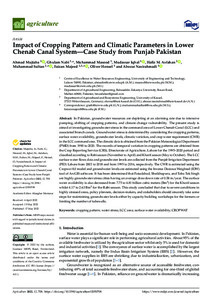| dc.date.accessioned | 2022-08-22T14:48:10Z | |
| dc.date.available | 2022-08-22T14:48:10Z | |
| dc.date.issued | 2022-05-17 | |
| dc.identifier | doi:10.17170/kobra-202208196704 | |
| dc.identifier.uri | http://hdl.handle.net/123456789/14092 | |
| dc.description.sponsorship | Gefördert durch den Publikationsfonds der Universität Kassel | ger |
| dc.language.iso | eng | eng |
| dc.rights | Namensnennung 4.0 International | * |
| dc.rights.uri | http://creativecommons.org/licenses/by/4.0/ | * |
| dc.subject | cropping pattern | eng |
| dc.subject | water stress | eng |
| dc.subject | LCC area | eng |
| dc.subject | surface water availability | eng |
| dc.subject | CROPWAT | eng |
| dc.subject.ddc | 550 | |
| dc.subject.ddc | 630 | |
| dc.title | Impact of Cropping Pattern and Climatic Parameters in Lower Chenab Canal System - Case Study from Punjab Pakistan | eng |
| dc.type | Aufsatz | |
| dcterms.abstract | In Pakistan, groundwater resources are depleting at an alarming rate due to intensive pumping, shifting of cropping patterns, and climate change vulnerability. The present study is aimed at investigating groundwater stress in the command area of Lower Chenab Canal (LCC) and associated branch canals. Groundwater stress is determined by considering the cropping patterns, surface water availability, groundwater levels, climatic variation, and crop water requirement (CWR) in the LCC command area. The climatic data is obtained from the Pakistan Meteorological Department (PMD) from 1990 to 2020. The records of temporal variation in cropping patterns are obtained from the Crop Reporting Service (CRS), Directorate of Agriculture, Lahore for the 1995–2020 period and classified according to Rabi season (November to April) and Kharif season (May to October). The LCC surface water flows data and groundwater levels are collected from the Punjab Irrigation Department (PID) Lahore from 2003 to 2018 and from 1995 to 2016, respectively. The CWR is estimated using the Cropwat 8.0 model and groundwater levels are estimated using the Inverse Distance Weighted (IDW) tool of ArcGIS software. It has been determined that Faisalabad, Sheikhupura, and Toba Tek Singh are highly groundwater stress cities having an average drawdown rate of 0.58 m/year. The surface water availability is also decreased from 7.75 to 4.81 billion cubic meters (Bm3) for the Kharif season whilst 4.17 to 2.63 Bm3 for the Rabi season. This study concluded that due to severe conditions in highly stressed areas, policy planners, decision-makers, and stakeholders should sincerely take some steps for maintaining groundwater levels either by capacity building workshops for the farmers or limiting the number of tubewells. | eng |
| dcterms.accessRights | open access | |
| dcterms.creator | Mujtaba, Ahmad | |
| dcterms.creator | Nabi, Ghulam | |
| dcterms.creator | Mosood, Muhammad | |
| dcterms.creator | Iqbal, Mudassar | |
| dcterms.creator | Asfahan, Hafiz Muhammad | |
| dcterms.creator | Sultan, Muhammad | |
| dcterms.creator | Majeed, Faizan | |
| dcterms.creator | Hensel, Oliver | |
| dcterms.creator | Nasirahmadi, Abozar | |
| dc.relation.doi | doi:10.3390/agriculture12050708 | |
| dc.subject.swd | Pakistan | ger |
| dc.subject.swd | Punjab (Pakistan) | ger |
| dc.subject.swd | Anbau | ger |
| dc.subject.swd | Wasserstress | ger |
| dc.subject.swd | Oberflächenwasser | ger |
| dc.subject.swd | Wasserversorgung | ger |
| dc.subject.swd | Grundwasser | ger |
| dc.type.version | publishedVersion | |
| dcterms.source.identifier | eissn:2077-0472 | |
| dcterms.source.issue | Issue 5 | |
| dcterms.source.journal | Agriculture | eng |
| dcterms.source.volume | Volume 12 | |
| kup.iskup | false | |
| dcterms.source.articlenumber | 708 | |


